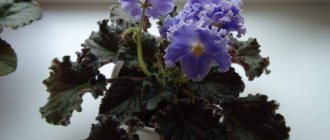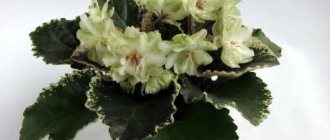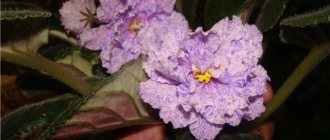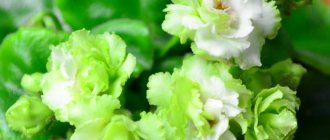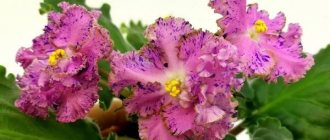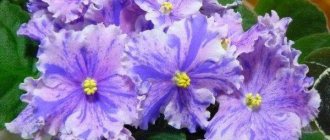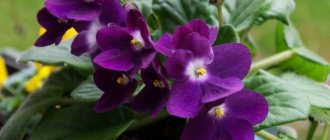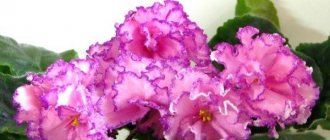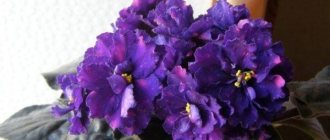Uzambara violet.
Family Gesneriaceae - Gesneriaceae.
Genus Saintpaulia hybrida - Hybrid Saintpaulia.
African violet saintpaulia hybrid.
Violets from breeders of the CIS countries - “D” (EK).
EK- Wild Cat (E. Korshunova).
EK-Wildcat, EK-Dikaya Koshka (E. Korshunova).
Large, densely double, fluffy, smoky-lilac, half-bell-shaped flowers with bright purple tips of the petals (like a cat’s ears).
Dark green compact rosette of pointed leaves. The variety is distinguished by a compact self-forming rosette. The rosette holds perfectly in any conditions, the petioles do not stretch. The size of the rosette is 17 cm, and the size of the flowers is 5 cm.
Large smoky lilac double flowers. Cap flowering at any age. The first flowering, and immediately lush and captivating! A lot of buds. The variety keeps flowers fresh for a long time, is not capricious, grows quickly, and blooms in a cap. It has strong short peduncles located vertically.
Unpretentious, always with flowers. There are three flowers on the peduncle. Not demanding on lighting. Wherever it stands, even on the side of the lamp, even in the farthest corner of the shelf, it always forms the perfect socket and the perfect hat. The flowers don't even lean towards the lamp.
Tsvetun, at the same time, stands on the north window both in summer and winter and does not even raise his hands up. In summer, the blooms are brighter and richer in color. The variety loves regular watering and good humidity. It conveys varietal characteristics well when propagated by cuttings.
A cat is a mammal of the cat family of the order Carnivora. The domestic cat is one of five subspecies of the wild cat (Felis silvestris). Currently, there are about 600 million domestic cats in the world, about 200 breeds have been bred. Secondary feral cats can exist in urban ecosystems without direct human intervention. In urban environments, stray cats often form entire colonies in which their offspring are raised together.
Do you know that…?
Two-color and three-color non-fantasy varieties. By two-color we mean varieties with a spot on each petal (the so-called finger color or imprint), an eye, a double border, a wide chimera-like border or smooth color transitions. Such varieties, unlike fantasy ones, usually pass on varietal characteristics to the offspring, that is, the likelihood of getting the sport here is quite low.
Properties
Name
- Original: EK-Wild Cat
- Transcription:
- Translation:
Registration
- Selection: E. Korshunova
- Year: 2009
Socket
- Socket type: standard
Flower
- Flower size, up to: 5 cm
- Flower shape: half bell
- Terry: terry
- Main color: lilac
- Color type: two-tone
- Border:
- Other Features: Darkened tips
Foliage
- foliage color: dark green
- foliage type: simple
- foliage shape: pointed; smooth
- reverse side of sheet: pink
- leaf edge: jagged edge
- variegation: absent
The most common violets in the wild
The most popular representative of wild violets is field violets . The corolla of this flower has separate petals. Terry petals are white with yellow splashes and a green edging along the edge, making the plant recognizable among other varieties of the genus. This representative of the genus most often grows in:
- Fields;
- Or a forested area.
IMPORTANT! This flower is quite often mistaken for a weed, precisely because of its unpretentiousness to the area where it grows.
Field
reach at least 1.5 centimeters in height . It has a straight dark green stem and one brown root. Easily adapts to both natural and domestic conditions, as well as indoor conditions. Field violet can be grown on a windowsill just like other cultivated varieties.
The most famous are field violets.
Altai
Altai violet flowers can reach 3 centimeters in diameter. This species begins to bloom from the end of April. The flowering period lasts at least 40 days, after which a dormant period begins. The second flowering phase begins in August and lasts until the first snow appears.
Altai violet has large flowers.
For Altai Saintpaulia, a light area with well-drained soil is preferable.
ATTENTION! This species can overwinter without cover.
Yellow
Yellow-green crenate leaves and bright yellow flowers make the flower stand out among others . The stem of this beauty is erect. The plant can reach 10-20 centimeters in height.
Yellow violet grows up to 20 cm in height.
The flowering diameter ranges from 2.5 to 4 centimeters.
Cropped
The plant is perennial and very rare. Most often you can find it in Siberia. This type of violet is stemless . Bushy. The height of the bushes can reach 6-15 centimeters. Propagated by seeds. In order for the seeds to germinate they need:
- Bright lighting;
- And high air temperature.
Clipped violets are very rarely found in nature.
Seeds germinate at a temperature of 22-30 degrees .
Aetolian
Aetolian violet is a perennial . The bushes reach 10, less often 15 centimeters in height. Leaves:
- Small;
- Oval shape.
The Aetolian violet has small leaves.
The flowers are a soft purple hue with yellow splashes. Most often this type is used to decorate rock gardens .
Doggystyle
Perennial, reaches a height of up to 15 centimeters. Occurs :
- In the Caucasus;
- In Siberia;
- And also in the Far East.
Dog violet.
The flowers are axillary, no more than 2.5 centimeters in diameter. Dog violet is very easy to confuse with field violet . Their difference is that the latter is most often monochromatic in color.
Kholmovaya
This rare beauty grows :
- In bright forests;
- In the vastness of Eurasia;
- More often in Central Europe;
- And also in China and Japan.
Hill violet can most often be found in the mountains.
The perennial reaches up to 15 centimeters in height . The plant has blue or light purple flowers. Blooms in April and May.
Stopoid
Perennial flower up to 8 centimeters in height. It has :
- Thick rhizome;
- And single velvety flowers.
Stop-shaped violet.
Flowering may be dark blue or purple. There are also .
Hairy
A perennial, stemless flower with a thick rhizome. It blooms in May and stops blooming by June.
Hairy violet.
The flowers are small, 10-12 centimeters, lilac-lilac in color. They have no smell.
Palm-shaped
Perennial spreading flower. It has :
- Dissected leaves;
- And small flowers.
Palm violet.
Propagates well in dry, well-drained soil. Frost-resistant. Reproduction method - self-seeding .
Reichenbach
Perennial flowering bushes, no more than 35 centimeters in height. Frost-resistant , prone to self-seeding. Blooms profusely throughout May.
Reichenbach violet.
Bolotnaya
Perennial. Geography of its distribution :
- Europe;
- Asia;
- North America.
Swamp violet.
Grows in swamps and peat bogs. This plant prefers a damp, humid climate , natural for swamps and swamps.
Skalnaya
A loose perennial bush no more than 10 centimeters in height. Flowers no larger than 12 centimeters are purple . In natural conditions it grows:
- On the slopes of the mountains;
- Wasteland;
- In forests.
Rock violet.
Peculiarities
Large smoky-lilac double flowers on strong short peduncles arranged vertically. Each peduncle has three flowers, which fit tightly together and form a good cap. Flowering is frequent and always in a bouquet.
The rosette of dark, pointed leaves is smooth and compact, and forms itself. The variety is not demanding on lighting, the rosette is small and neat in any light, the petioles do not stretch.
The variety is easy to care for, conveys varietal characteristics well when propagated by cuttings, and can produce a good bouquet already in the first flowering.
EK-Wild Cat, photo by Elena Novikova:
wild violet
When it comes to wild violet, it is worth understanding that this variety represents a whole group of plants , diverse in:
- Appearance;
- Shape;
- And the type of flowering.
In addition, each of the subspecies has its own color scheme, as well as features :
- Transplants;
- Care;
- And reproduction.
In nature, a group of wild violets is a fairly unpretentious plant , so if you need to replant its representatives at home, any soil will do.
ATTENTION! Representatives of the genus often grow in fields, as well as in forest areas or on mountain peaks.
The field violet is most often found in the west , as well as in the south of Siberia. In addition, this flower is suitable for the climatic conditions of central and western Europe.
The main feature can be considered the ability of the plant to easily adapt to any climate changes. Field beauties are able to withstand both heat and fairly severe frosts. However, this will not affect their development or flowering.
Unlike indoor ones, field Saintpaulias do not suffer from :
- From lack of lighting, heat;
- And they do not require regular watering.
It is also important that absolutely any soil is suitable , and they can also be grown in open ground.
The wild violet group consists of more than ten plant species. They all differ in shape, size, and color. Additionally, some of them have straight stems, while others are considered to be so-called stemless plants.
The main difference between wild and garden violets can be called the unpretentiousness of the former to certain climatic conditions , or specific specialized care.
Reviews
I really love this variety! From the first flowering the rosette is almost a head and neat. I'll show you my beauty (the first flowering of a young starter):
- Login or register to post comments
Some varietal violets
There are several cultivated varieties of violets , the names of which contain the word wild. More details below.
EK-Wild Cat
Double flowers of a smoky lilac hue with purple tips. The size of the rosette is about 17 centimeters. The flowering size is at least 5 centimeters.
Violet EK-Wild Cat.
Bell BR-Wild Angel
BR - Wild Angel photo and description of the variety. Flowering in the form of small bells of pale pink color.
Violet bell BR-Wild Angel.
SM-Wild Angel
Velvety voluminous flowers of soft pink color with yellow splashes. Large velvety dark green leaves with a round shape .
Violet SM-Wild Angel.
EK-Wild Orchid
Dark purple double flowers with fringe along the edges of the petals. The blooms are shaped like an orchid .
Violet EK-Wild Orchid.
EK-Wild Rosehip
Large double flowers of pink color with a white border along the edges of the petals.
Violet EK-Wild Rosehip.
CM-Wild Cat
Violet Wild Cat. Flowers in the form of miniature pink stars with a purple edging along the edge of the petals.
Violet CM-Wild Cat.
